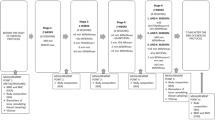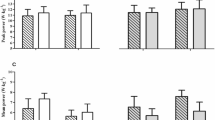Summary
The levels of serum osteocalcin, in addition to other parameters, were monitored in athletic (N=9) and nonathletic (N=10) university male students before, immediately after, and 60 min after 30 min of exercise on a running ergometer and at a constant workload of approximately 50% of their maximum capacity; there was adequate replenishment of drinking water. In both groups, the increase in serum parathyroid hormone levels observed immediately after exercise correlated well with a decrease in ionized calcium as well as the total calcium, and also with an increase in serum phosphorus, whereas the concentration of serum albumin remained stable. The response of serum osteocalcin differed between the two groups, in that (1) the concentration before exercise was significantly higher in athletic than in nonathletic students (P<0.001), and (2) the maximum level was evident in the former group 60 min after exercise, whereas it was present in the latter group immediately after exercise. We speculate that athletic subjects have a higher turnover of bone status compared with nonathletic subjects.
Similar content being viewed by others
References
Habener JF, rosenblatt M, Rotts JT (1984) Parathyroid hormone: biochemical aspects of biosynthesis, secretion, action, and metabolism. Physiol Rev 64:985
Brown EM, Hurwitz SH, Aurbach GD (1977) Beta-adrenergic stimulation of cAMP content and parathyroid hormone release from isolated bovine parathyroid cells. Endocrinology 100:1692
Brown EM, Hurwitz SH, Aurbach GD (1978) Alpha-adrenergic inhibition of adenosine 3′, 5′-monophosphate accumulation and parathyroid hormone release from dispersed bovine parathyroid cells. Endocrinology 103:893
Nielsen SP, Christiansen TF, Harting O, Trap-Jensen J (1977) Increase in serum ionized calcium during exercise. Clin Sci Mol Med 53:579
Ljunghall S, Joborn H, Benson L, Fellstrom B, Wide L, Akestrom G (1984) Effects of physical exercise on serum calcium and parathyroid hormone. Eur J Clin Invest 14:469
Ljunghall S, Joborn H, Lundin L, Rastad J, Wide L, Akerstrom G (1985) Regional and systemic effects of short-term intense muscular work on plasma concentration and content of total and ionized calcium. Eur J Clin Invest 15:248
Cunningham J, Segre GV, Slatopolsky E, Avioli LV (1985) Effect of heavy exercise on mineral metabolism and calcium regulating hormones in humans. Calcif Tissue Int 37:598
Van Beaumont W, Strand JC, Petrofsky JS, Hipskind SG, Greenleaf JE (1973) changes in total plasma concent of electrolytes and protein with maximal exercise. J Appl Physiol 34:102
Ljunghall S, Joborn H, Roxin L-E, Rastad J, Wide L, Akerstrom G (1986) Prolonged low-intensity exercise raises the serum parathyroid hormone levels. Clin Endocrinol 25:535
Lian JB, Friedman PA (1978) The vitamin K-dependent synthesis of γ-carboxyglutamic acid by bone microsomes. J Biol Chem 253:6623
Nishimoto SK, Price PA (1979) Proof that the γ-carboxyglutamic acid-containing bone protein is synthesized in calf bone. J Biol Chem 254:437
Price PA, Parthemore JG, Deftos LE (1980) New biochemical marker for bone metabolism. J Clin Invest 66:878
Slovik DM, Gundberg CM, Neer RM, Lian JB (1984) Clinical evaluation of bone turnover by serum osteocalcin measurements in a hospital setting. J Clin Endocrinol Metab 59:228
Nishiyama S, Fujimoto S, Kodama M, Matsuda I (1985) The negative correlation between prolactin and ionic calcium in cord blood of full-term infants. Endocrinol Japon 32:9
Durstine JL, Miller W, Farrel S, Sherman WN, Ivy JL (1983) Increase in HDL-cholesterol and the HLD/LDL cholesterol ratio during prolonged endurance exercise. Metabolism 32:993
Ravussin E, Bogardus C, Scheidegger K, Lagrange B, Horton ED, Horton ES (1986) Effect of elevated FFA on carbohydrate and lipid oxidation during prolonged exercise in humans. J Appl Physiol 60:893
Warshaw AL, Lee K-H, Napier TW, Fourtier PO, Duchainey D, Axelrod L (1985) Depression of serum calcium by increased plasma-free fatty acids in the rat: a mechanism for hypocalcemia in acute pancreatitis. Gastroenterology 89:814
Kruse K, Kracht K (1986) Evaluation of serum osteocalcin as an index of altered bone metabolism. Eur J Pediatr 145:27
Gundberg CM, Markowitz ME, Mizruchi M, Rosen JF (1985) Osteocalcin in human serum: a circadian rhythm. J Clin Endocrinol Metab 60:736
Price PA, Baukol SA (1980) 1,25-dihydroxyvitamin D3 increases synthesis of the vitamin K-dependent bone protein by osteosarcoma cells. J Biol Chem 255:11660
Morkowitz ME, Gundberg CM, Rosen JF (1987) The circadian rhythm of serum osteocalcin concentrations: effects of 1,25-dihydroxyvitamin D administration. Calcif Tissue Int 40:179
Lukert BP, Higgins JC, Stoskopf MM (1986) Serum osteocalcin is increased in patients with hyperthyroidism and decreased in patients receiving glucocorticoids. J Clin Endocrinol Metab 62:1056
Price PA, Williamson MK, Lothringer JW (1981) Origin of the vitamin K-dependent bone protein found in plasma and its clearance by kidney and bone. J Biochem (Tokyo) 256:12760
Galbo H (1983) Hormonal and metabolic adaptation to exercise. Georg Thieme Verlag, New York, p 40
Minaire P, Meunier P, Edouard C, Bernard J, Coupron P, Bourret J (1974) Quantitative histological data on disuse osteoporosis: comparison with biological data. Calcif Tissue Res 17:57
Naftchi NE, Viau AT, Sell GH, Lowman EW (1980) Mineral metabolism in spinal cord injury. Arch Phys Med Rehabil 61:139
Simmons DJ, Nichols G (1966) Diurnal periodicity in the metabolic activity of bone tissue. Am J Physiol 210:411
Simmons DJ, Whiteside LA, Whitson SW (1979) Biorhythmic profiles in the rat skeleton. Metab Bone Dis Rel Res 2:49
Author information
Authors and Affiliations
Rights and permissions
About this article
Cite this article
Nishiyama, S., Tomoeda, S., Ohta, T. et al. Differences in basal and postexercise osteocalcin levels in athletic and nonathletic humans. Calcif Tissue Int 43, 150–154 (1988). https://doi.org/10.1007/BF02571312
Received:
Revised:
Issue Date:
DOI: https://doi.org/10.1007/BF02571312




